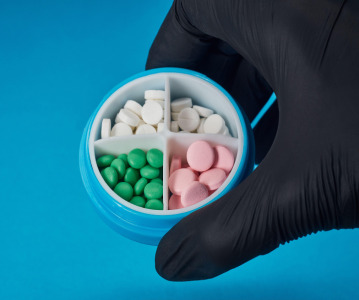The CPO Starter Pack: Why and When to Bring in a Contract Packaging Partner
.png)
Discover the trends affecting the pharmaceutical CPO market, when and why outsourcing may be an enticing option, and what is driving pharmaceutical companies and CDMOs to partner with outsourced packaging and drug delivery organisations.
Pharmaceutical contract packaging organisations (CPOs) have traditionally been associated with larger CDMOs offering outsourcing solutions with full-service manufacturing capabilities from development to commercialisation [i]. However, with consumer and client demands increasing the complexity of packaging challenges, independent CPOs have become highly promising partners within the pharmaceutical supply chain to meet specific packaging, regulatory, and sustainability requirements, especially for those pharmaceutical companies struggling to keep up with required capabilities and budget constraints.
Outsourcing throughout the supply chain has been an increasing trend for the pharma industry, with CDMOs dominating the conversation with outsourced manufacturing [ii]. As the world increasingly moves towards a post-COVID period, outsourced pharmaceutical packaging and drug delivery solutions are poised to grow at a CAGR of 7.1% by 2027, totalling a value of USD $47.7 billion [iii].
In this article, we examine the trends affecting the pharmaceutical CPO market, when and why outsourcing may be an enticing option for some, and what considerations drive outsourced packaging and drug delivery decisions.
‘Crate’ expectations for pharmaceutical packaging
Though pharmaceutical packaging can sometimes strictly refer to the materials, construction, and physical/chemical composition of packaging utilised for containing and transporting drug products, contract packaging services often encompass a wide range of services, as Edgar Pogna, Engagement Manager, Life Science at L.E.K. Consulting explains: “When we think about contract packaging, we’re really thinking about the final step in the production of pharmaceuticals and medical devices, so whether you’re moving a formulated medical product into its final container or its final physical form... all the development and decisions about how the products needs to be prepared has already been made, it is more a question about what is the best container and what the best medium is to transfer that specific kind of product.” Verena Ahnert, Partner at L.E.K. Consulting, also makes note of the overlap between "packaging as a service, the actual procedure of filling a container with the drug product, and a very strong overlap between CMOs and packaging providesr on the primary packaging front. CMOs produce the actual drug formulations and do the fill and finish into the primary packaging. That service is largely with the CMO, but the packaging provider actually produces and sells the container, which is rarely done by a CMO and, I would say, is also rarely done in-house by a pharmaceutical company. It’s a very specialist expertise.”
Additionally, secondary and tertiary packaging requirements offer increased variability as to the service requirements demanded from a CPO, and veers into the territory of product handling and transportation. Products with cold chain requirements, therapeutics with highly potent APIs, and other environment-sensitive products require very particular and sometimes complicated vessels to preserve the stability of the product, states Pogna. Kristin Smith, Client Coordinator at Sharp, further explains that “beyond core packaging activities (primary, secondary, and tertiary), so much more goes into packaging a [therapeutic]. A CPO offers an array of services complementary to core packaging activities including packaging design, serialisation and aggregation, engineering to support custom production lines, continuous improvement culture, qualified person (QP) services, foreign-trade zone (FTZ) locations, and specialty distribution services.”
The increased complexity of packaging demands by both government bodies and healthcare regulators have caused pharmaceutical companies of all sizes to consider the benefits of a CPO and outsourcing the packaging for their drugs and therapeutics. Smith states that the industry has “seen continued growth in injectables, specifically biologics, as well as cell and gene therapies in the pipeline. These therapies often require specialised packaging and distribution capabilities (cold chain, time sensitive handling etc.).”
The pharmaceutical industry showcased its rapid innovation from the very start of the COVID-19 pandemic, rolling out vaccines for a novel virus utilising innovative mRNA technology and two new novel excipients [iv]. However, such innovation in drug device and packaging remained far behind as attention remained narrowly focused on developing a therapeutic throughout the supply chain. Respondents to the Pharmapack Survey and Annual Report 2023 were divided on whether packaging innovation had accelerated accordingly, with nearly 40% stating that drug device and packaging product development had slowed during the pandemic [v]. Significant supply chain disruptions, the effects of an accelerated vaccine delivery program for COVID-19, and lockdown and travel restrictions hindering business development and partnership have contributed to stagnated innovation in the last 3 years [v]. Developing new packaging innovations for specific pharmaceutical products can oftentimes be time- and cost-intensive, with not every potential product making it to the market in time [vi]. It is no mystery why an industry searching to reduce risk wherever possible would continue to minimise any form of risk with their packaging. Experimenting with packaging designs, materials, and labelling could entail potential investment losses and unpopular designs for consumers, which could affect a company’s reputation [vi].
Smith added that “There’s also a growing demand for sustainable packaging materials and adopting sustainable practices and processes, which in turn is driving more collaboration across various stakeholders in the industry.” Regulations related to reusability and sustainability have put mounting pressure on the pharmaceutical industry, with the European pharmaceutical industry federation (EFPIA) expressing concern over the EU’s proposed requirement for more recycling and re-use of packaging materials [vii]. Though there will be some exemptions towards the pharmaceutical industry to the proposed regulations (such as exclusion from requirements regarding minimum recycled plastic content [vii]), there will undoubtedly remain some concern for pharmaceutical innovators when making decisions regarding their medicinal packaging.
With all this in mind, it is of little wonder that major players in the pharmaceutical supply chain are increasingly looking towards CPOs to outsource an essential step of drug production and distribution, but one that may draw time, costs, and energy away from a business’s core competency in research, development, and manufacturing. As one of the most highly regulated industries across the world, several specific considerations must be made regarding pharmaceutical packaging. CPOs offer pharma supply chain businesses the ability to focus on core competencies by specialising in a very specific step in the production of drug products and pharmaceuticals. However, the contract packaging sector is not without its own particular set of challenges.
Pharmaceutical packaging market trends and challenges
From the development and production of primary, secondary, and tertiary packaging to trending market demands such as postponement packaging and serialisation and sustainability concerns, there are several aspects related to packaging that all pharmaceutical players must evaluate, whether they decide to utilise their in-house packaging capabilities or outsource these needs.
Postponement packaging
With environmental sustainability a remaining concern across the pharmaceutical supply chain, postponement packaging has become an increasingly common trend amongst practicing CPOs. In short, postponement packaging is a late-stage customisation option in which standard package templates are kept blank and customised according to market demands rather than producing a bulk order of single products for specific markets and/or customers [viii]. “Traditionally, CPOs provided a bulk packaging service where large volumes of pharmaceutical products were packed, then shipped before being stored in a warehouse until the product was required. Due to volatile market demand, this approach quite often produces a lot of waste product and can also incur high inventory costs in multiple locations,” Julia Leonteva, Business Development and Marketing Officer for Tjoapack explains.
For CPOs, postponement packaging offers a flexible way to rapidly meet market demands while reducing their inventory of finished goods, reducing potential waste and repackaging products. While not a new concept, postponement packaging is a relatively new practice for CPOs [viii]. However, the adoption of postponement packaging has yet to see a widespread effect: “While there are some specialised CPOs that are already equipped to package products in this way, adoption of postponement packaging has been sporadic, with some companies reluctant to tackle its complexity or invest in new processes and infrastructure, which, for medicines, can be a substantial undertaking,” Leonteva states. “Nonetheless, as nuanced interpretations of the FMD, as well as domestic regulations and the need to cater to different languages create a need for more flexible packaging processes, postponement is becoming more attractive to companies supplying to multiple markets. In this kind of environment, postponement offers huge opportunities to improve efficiencies, reduce costs and waste, and lower the likelihood of reworks being required.
In the longer-term, postponement could overhaul the way that healthcare is delivered to patients, leading to patient specific packaging, ultimately increasing patient safety and adherence.”
Serialisation and labelling
Serialisation challenges have also become a rising concern for many within the contract packaging industry [i]. Regulations imposed in the US by the Drug Supply chain Security Act and the EU’s Falsified Medicines Derivative require the use of unique numerical identifiers for each prescription product unit [ix]. These serial numbers provide information on the product’s origin, validity date, and batch number, and are printed as barcodes on shipping boxes as well as the label for each unit. By 2023, an electronic serialisation and tracking system will be required from all manufacturers in order to track prescription therapeutics through the pharma distribution and supply chain. “Serialisation has been widely discussed across the industry since the FMD and DSCSA regulations were first announced and the implementation of new systems to meet legislation will have a lasting effect on the industry,” says Leonteva. Though serialisation requirements can benefit the distribution chain by providing transparency, efficiency, and security, there remain certain challenges for the industry to adapt [ix]. Implementing label redesign, maintaining production efficiency, and constructing the proper data management system can take time and significant investments for the installation of such structures.
“The introduction of mandatory barcodes and the management and transfer of the huge amounts of data generated by serialisation has increased the complexity of pharmaceutical packaging and created significant cost-barriers. Consequently, many drug manufacturers and CMOs have been slow to adopt serialisation. However, it’s vital that companies look beyond these challenges and see the scope of serialisation systems, which will not only lead the industry towards a safer and more secure supply chain, but ultimately help to connect the whole industry, from manufacturer to patient.”
Advanced therapeutics, basic packaging
Biologics and large molecule therapeutics have marked a significant change in the complexity of drugs and medications available. Such drug products derived from living tissue and organisms are inherently more complex than traditional small molecule synthetic products and may require equally complex and advanced packaging to preserve therapeutic effectiveness and stability [x]. Pharmaceutical packaging experts and companies must also take into consideration chemical and physical interactions between the drug product and the packaging itself. With biologics comprising over half of the ten best-selling drug in 2020, pharmaceutical companies are scrambling to meet the demanding intricacies of packaging for biologics and large molecule therapeutics. Leonteva also cites the rise of customised and personalised medicines as a complicating factor in packaging. “Market demand for [customised medicines] require more complicated packaging solutions that CPOs have the most expertise in,” states Leonteva. “Internal packaging operations may not always offer the same level of flexibility and efficiency in delivering packaging solutions, as well as the advanced technology and specialised expertise available through outsourcing to a CPO.”
The logistics of sustainability
Sustainability challenges related to pharmaceutical packaging, whether logistical or regulatory, are a growing concern for all across the pharma supply chain, but especially for CPOs. “Sustainability efforts were less focused on primary packaging, originally, and they were more focused on production and sourcing, as well as reducing emissions and water or energy usage. Part of that was because regulators specifically stated that pharma packaging was exempt from sustainability requirements because patient safety takes precedence,” Karin von Kienlin, Senior Partner at L.E.K. Consulting explains. “However, even just a few years back there was already quite a push on secondary packaging – do you really need a leaflet with instructions in 46 languages? Can you save on paper and put a QR code?” Now with the draft EU regulations on sustainability for pharma packaging that stipulates recyclability of even primary pharma packaging by 2035, von Kienlin highlights that such demand are already putting pressure on primary packaging providers to provide multi-laminate structures that cannot be recycled with other solutions that can. Given needs for shelf life, superior barrier properties are key. They are also hard to create with mono-material and/or mono-layer packaging options. However, for CPOs, von Kienlin sees opportunity: “It’s a large opportunity for innovative new solutions winning share and what’s more, the industry is talking not only about changing for new drugs, but also for existing drugs that would need to be requalified from a packaging point of view.”
Leonteva offers some advice for CPOs looking to implement more environmentally conscious practices to their methodologies: “By introducing more environmentally conscious approach to the following areas of pharmaceutical packaging:
-
Manufacturing process itself: by more introducing conscientious use of the recourses and optimizing manufacturing processes.
-
Material selection: Choosing sustainable materials for packaging can significantly reduce the environmental impact of pharmaceutical products.
-
Packaging design: There is room for improving the packaging design particularly in terms of implementing more precise package sizing, which could lead to a reduction in the amount of leftover packaging materials following packaging.
-
Recycling materials on site.
-
Optimizing the supply chain solutions.
Using digitalisation to help improve the environmental impact of packaging manufacture. The whole production process can be optimized with the help of digitalization by introducing the real-time monitoring and control of all the processes, eliminating production errors and helping with more conscious use of the resources. This will be a huge step towards reducing the negative effect on the environment.
Digitalization can improve packaging design solutions as well allowing to use less amount of packaging materials for example by putting a barcode on the pack instead of inserting a leaflet.
Digital supply chain will give more control over forecasting making it more precise as well as help with cutting down transportation emissions.”
Choosing a CPO: decision-making drivers and considerations
Packaging innovations with less risk
As with any outsourcing service, CPOs offer an attractive portfolio of incentives for pharmaceutical companies, such as implementing new packaging advances with less risk associated [xi]. Advanced therapeutics have increased the need for innovative packaging solutions, especially as the main pharmaceutical packaging material, glass, has seen little change since its first implementation some 140 years ago [xi]. CPOs can a number of advanced yet cost-effective solutions for drug handling, packaging, and transportation based on client needs [xii]. Pharmaceutical companies can thus focus their efforts on innovative drug and therapeutics research and development.
Leonteva attributes the rise in pharmaceutical innovation to COVID-19, ageing populations across the world, and the rise in interest in personalised medicine for the growth of the CPO market: “Overall growth of the pharmaceutical market creates additional demand for packaging services, which not all the pharma companies that have in-house packaging are able to carry out without the CPOs help,” she says.
Growing markets in cell and gene therapies and mRNA vaccines will be particular drivers in developing packaging innovation within the CPO market, as well as ensuring the safety and efficacy of the drug products. “CPOs must adapt to the industry, and client and drug requirements in order to remain relevant and grow with the pharma industry. Gene therapy is a perfect example – we've adopted advanced cold chain solutions and specialised packaging to withstand cryogenic temperatures, as well as transforming to a patient-led demand model,” Smith answers.
Serialisation solutions
With the growth of challenges related to serialisation, more and more pharmaceutical companies are looking to outsourced packaging services
“Most CPOs have a grand expertise and everything in place to perform serialisation, which allows pharmaceutical firms to comply with serialisation requirements without having to spend resources on developing their own procedures. CPOs are also trying to keep up with the latest digitalisation trends evolving in the pharma industry and implement latest achievements into their solutions,” explains Leonteva. “Streamlining the exchange, interpretation and processing of data across enterprise systems and through entire supply chains has huge potential. Companies will be able to look at legacy data and optimise their logistics operations through real-time monitoring, resulting in accurate demand planning as opposed to assumption-based forecasting, as well as improved warehouse management, shipment visibility and more efficient distribution.
Ultimately this could mean a safer, more integrated and faster approach to bringing new drugs to market, to the benefit of patients and primary healthcare providers,” she comments.
When to bring in a CPO partner
One aspect to consider, experts suggest, is when to engage a CPO partner for your outsourced packaging needs. Smith comments that “a pharma/biotech company should consider engaging a CPO for a commercial launch in late phase II/early phase III to begin discussing design. Working with commercial packaging design experts at the clinical trial stage will help ensure a more successful packaging design. Addressing packaging configuration flexibility, componetry as it relates to commercial scale-up, and human factors studies help improve end-user experience and greater patient adherence.”
Pogna agrees, claiming packaging decisions can be made as soon as a clinical trial starts: “Already, when you use a phase I product, you can test different mediums. Most recently, we had a lot of discussion around vaccines, with a lot of new formulations trialling nasal sprays to avoid needles. Those are decisions that can be made really early on because the old value proposition is that you don’t want to use a syringe. In that sense, you’re packaging decision becomes your value proposition. Classic oral or standard syringe treatments may not have a complete decision until phase III or pre-reg, but most of the time, by the start of phase III, you need to make a decision on something as close to the product that will be on the market.”
More than just core competencies
Ahnert comments that the CPO space remains a very select space, with few overlaps in core capabilities to broader pharmaceutical companies. Bringing in a CPO can help pharmaceutical companies and CDMOs focus on their core competencies. “I think the decision to not do [packaging] in-house is relatively clear-cut unless they have a highly diversified business model where they serve different types of customers. I think it’s quite unusual to have this under one roof and they will use the manufacturing of the packaging company (or they buy it in),” she asserts. While more and more parts of the drug development, manufacturing, and packaging process are being outsourced to commercial partners, pharmaceutical companies and CDMOs can then focus on their own core business.
“Some of the big pharma companies might have had [packaging] in-house in the past, but their focus for a long time now has been on core competencies – that for them can even means outsourcing big portions of R&D or the running of clinical trials, or some of the earlier stages of complex discovery. They want to be leaner in areas that are not as close to their core and their core is origination/early discovery, ownership of the R&D process (with lots of steps outsourced), and late-stage decision-making, preparation, commercialisation, and launch,” Ahnert explains.
Summary
Though different CAGR figures will indicate different markets (with some describing a modest CAGR of USD $31.21 billion for a pure and direct market [xiii], while Pogna cites a a CAGR of USD $90–120 billion for a broader service inclusive of services that may overlap between CDMOs and CPOs), many experts agree that the value of CPOs to the pharmaceutical supply chain is expected to only grow into the future. Such growth can only mean more key decision-making on the part of pharmaceutical businesses regarding their pharma packaging requirements.
Whatever the reason pharmaceutical business, including CDMOs/CMOs, research organisations, and broader pharmaceutical companies, choose to outsource their packaging needs, it is important to consider the capabilities of the CPO and the reason for consulting a pharma packaging expert within the context of a changing industry tending towards innovation and sustainability.
If you’re active in the contract or commercial packaging space, find out more about how to expand your network and elevate your brand by exhibiting at Pharmapack 2024.
References
[i] Contract Packaging Organisations (CPOs) [Accessed April 13 2023] https://www.clearwaterinternational.com/uk/publications/outsourced-pharma-services/contract-packaging-organisations-cpos
[ii] The Future of Outsourcing – Strategies for Partner Selection [Accessed April 13 2023] https://informamarkets.turtl.co/story/the-future-of-outsourcing-strategies-for-partner-selection/
[iii] Pharmaceutical Contract Packaging Market Report, 2027 [Accessed April 13 2023] https://www.grandviewresearch.com/industry-analysis/pharmaceutical-contract-packaging-market
[iv] Accepting novel excipients for innovative drug development [Accessed April 17 2023] https://www.cphi-online.com/accepting-novel-excipients-for-innovative-drug-news118576.html?ref=lastvisitedcarousel
[v] Pharmapack Annual Report [Accessed April 17 2023] https://www.cphi.com/content/dam/Informa/pharmapackeurope/en/2023/pdf/Pharmapack-Annual-Report-2023.pdf
[vi] Why do Pharma Companies Outsource Pharmaceutical Packaging? [Accessed April 17 2023] https://pharmapackagingsolutions.com/blog/2021/10/06/why-do-pharma-companies-outsource-pharmaceutical-packaging/
[vii] Pharma Industry ‘Cautious’ Over EU Packaging & Recycling Proposals [Accessed April 20 2023] https://pink.pharmaintelligence.informa.com/PS147436/Pharma-Industry-Cautious-Over-EU-Packaging--Recycling-Proposals
[viii] Postponement: the solution for biotech packaging [Accessed May 5 2023] https://www.europeanpharmaceuticalreview.com/article/79171/postponement-biotech-packaging/
[ix] What Serialization Means for Pharma Manufacturing [Accessed May 5 2023] https://www.tigahealth.com/what-serialization-means-for-pharma-manufacturing/
[x] Four Trends Shaping the Future of Pharma Packaging [Accessed May 5 2023] https://www.forbes.com/sites/forbesbusinessdevelopmentcouncil/2022/01/18/four-trends-shaping-the-future-of-pharma-packaging/?sh=16cb65a4686c
[xi] Why Pharma Companies Outsource Packaging for Pharma products? [Accessed May 9 2023] https://www.paraspack.com/blog/why-pharma-companies-outsource-packaging-for-pharma-products/
[xii] Benefits of Outsourcing Pharma Packaging [Accessed May 9 2023] https://www.colemancontainers.com/benefits-of-outsourcing-pharma-packaging/
Related News
-
News Pharmapack Awards 2024 Patient-Centric Design Award Winner – Dr Ferrer BioPharma
The 2024 Pharmapack Awards celebrated the best in innovation and design for the pharmaceutical packaging and drug delivery industry on January 24, 2024. -
News Pharmapack Awards 2024 - Celebrating Packaging and Drug Delivery Innovation
The 2024 Pharmapack Innovation Awards ceremony celebrated the best in pharmaceutical packaging and drug delivery innovation at all levels. The awards were held on January 24, 2024 at the Paris Expo Porte de Versailles. -
News Women in Pharma: Looking back on 2023 and moving forward to 2024
In this monthly series, we interview women from across the pharmaceutical industry and supply chain to discuss the importance of gender diversity in healthcare, the workplace, and beyond. -
News On track at CPHI Barcelona - The Track Sponsor interview: USP
In our packed out content sessions at CPHI Barcelona this year we focus on some of the hottest topics coming up in the pharma industry, with each track sponsored by a leading expert in the field. -
News Women in Pharma: Marketing for the other half in healthcare
In our new monthly series, we interview women from across the pharmaceutical industry and supply chain to discuss the importance of gender diversity in healthcare, the workplace, and beyond. This instalment highlights not only the importance of ma... -
News Bringing the pharmaceutical supply chain closer to home
The pharmaceutical supply chain has encountered numerous disruptions in the last few years, impacting procurement, manufacturing, packaging, and distribution operations within the pharmaceutical industry. Read about the rise in calls for near/resh... -
News Delivering on mRNA-based therapeutics: innovations in applications and packaging
Since the onset of the COVID-19 pandemic, the innovative potential of mRNA vaccines and therapeutics has raised questions regarding their manufacturing, packaging, and storage/transportation. Learn about how the pharmaceutical supply chain is meet... -
News Your Prescription for Marketing Success: Digital Pharma Marketing Toolkit – Free eBook
Download your FREE pharma marketing eBook to learn why it is so important for pharmaceutical marketeers to develop their digital content marketing strategies in order to establish their companies as thought leaders and industry experts.
Position your company at the heart of the global Pharma industry with a CPHI Online membership
-
Your products and solutions visible to thousands of visitors within the largest Pharma marketplace
-
Generate high-quality, engaged leads for your business, all year round
-
Promote your business as the industry’s thought-leader by hosting your reports, brochures and videos within your profile
-
Your company’s profile boosted at all participating CPHI events
-
An easy-to-use platform with a detailed dashboard showing your leads and performance







